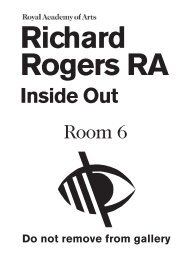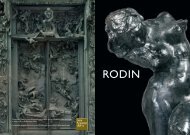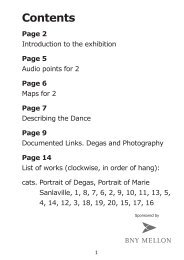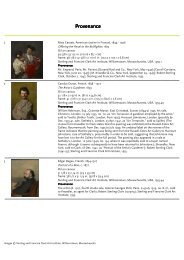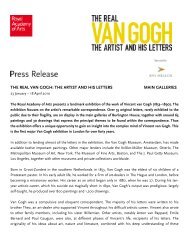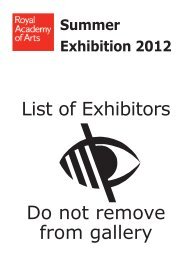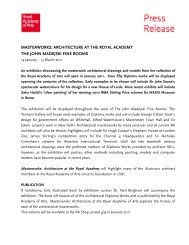Introduction to the Unknown Monet - Royal Academy of Arts
Introduction to the Unknown Monet - Royal Academy of Arts
Introduction to the Unknown Monet - Royal Academy of Arts
You also want an ePaper? Increase the reach of your titles
YUMPU automatically turns print PDFs into web optimized ePapers that Google loves.
<strong>Monet</strong><br />
THE UNKNOWN<br />
`<br />
PASTELS AND DRAWINGS<br />
Sackler Wing <strong>of</strong> Galleries<br />
17 March – 10 June 2007<br />
An <strong>Introduction</strong> <strong>to</strong> <strong>the</strong> Exhibition<br />
for Teachers and Students<br />
Written by Lindsay Rothwell<br />
Education Department<br />
© <strong>Royal</strong> <strong>Academy</strong> <strong>of</strong> <strong>Arts</strong><br />
The exhibition has been organised by <strong>the</strong><br />
Sterling and Francine Clark Art Institute,<br />
Williams<strong>to</strong>wn, Massachusetts,<br />
in association with<br />
<strong>the</strong> <strong>Royal</strong> <strong>Academy</strong> <strong>of</strong> <strong>Arts</strong>, London.<br />
Sponsored by<br />
COVER<br />
Detail <strong>of</strong> Cat.265<br />
Water Lilies, c.1918<br />
The Metropolitan Museum <strong>of</strong> Art,<br />
New York. Gift <strong>of</strong> Louise Reinhardt<br />
Smith, 1983 (1983-532)<br />
Pho<strong>to</strong> © 1998 The Metropolitan<br />
Museum <strong>of</strong> Art<br />
Designed by Isambard Thomas, London<br />
Printed by Tradewinds Ltd<br />
1<br />
<strong>Introduction</strong><br />
‘You must begin by drawing … Draw simply and directly, with charcoal,<br />
crayon or whatever, above all observing <strong>the</strong> con<strong>to</strong>urs, because you can<br />
never be <strong>to</strong>o sure <strong>of</strong> holding on <strong>to</strong> <strong>the</strong>m, once you start <strong>to</strong> paint.’<br />
CLAUDE MONET, 1920<br />
Despite his statement, Claude <strong>Monet</strong> (1840 –1926) spent most <strong>of</strong> his life<br />
staunchly denying <strong>the</strong> role drawing played in his creative process. Critics,<br />
biographers and journalists did not write about it, and his paintings were<br />
<strong>of</strong>ten praised for <strong>the</strong>ir lack <strong>of</strong> it. The reality, however, is that <strong>Monet</strong> carried<br />
pocket-sized sketchbooks with him throughout his life, setting out in<strong>to</strong><br />
nature <strong>to</strong> make notations and jot down scenes and people that caught<br />
his eye. <strong>Monet</strong> left eight folios <strong>of</strong> sketches, containing 400 individual<br />
drawings, <strong>to</strong> his son Michel, who in turn donated <strong>the</strong>m <strong>to</strong> <strong>the</strong> Musée<br />
Marmottan in 1966. They are reproduced digitally in this exhibition,<br />
allowing visi<strong>to</strong>rs <strong>to</strong> explore different periods in <strong>Monet</strong>’s artistic career.<br />
It is interesting <strong>to</strong> note that while his men<strong>to</strong>rs Eugène Boudin<br />
(1824–1898) and Johan Barthold Jongkind (1819–1891) left many more<br />
drawings as <strong>the</strong>ir legacies, not many sketchbooks belonging <strong>to</strong> <strong>Monet</strong>’s<br />
Impressionist peers have survived. Auguste Renoir (1841–1919) and<br />
Frédéric Bazille (1841–1871) left two sketchbooks each, Edouard Manet<br />
(1832–1883) and Alfred Sisley (1839–1899) one each and Gustave<br />
Caillebotte (1848–1894) left none. None <strong>of</strong> <strong>Monet</strong>’s sketches was ever<br />
shown or sold during his lifetime; in his eyes <strong>the</strong>ir value and purpose was<br />
as an early prepara<strong>to</strong>ry stage in <strong>the</strong> process <strong>of</strong> making a painting. He<br />
generally drew in pencil, and as Richard Kendall states in <strong>the</strong> catalogue,<br />
had ‘an accomplished hand, fluent not only in multiple languages <strong>of</strong> line,<br />
but in <strong>to</strong>ne, texture, and chiaroscuro.’ This level <strong>of</strong> skill and interest in<br />
drawing, although at odds with <strong>Monet</strong>’s publicised creative process,<br />
holds very true with <strong>the</strong> quote above and his desire <strong>to</strong> ‘hold on <strong>to</strong>’ <strong>the</strong><br />
con<strong>to</strong>urs within his paintings.<br />
<strong>Monet</strong> and <strong>the</strong> Impressionists<br />
Although Impressionist art is now largely seen as a pleasing, benign and<br />
almost universally beloved school <strong>of</strong> art, in <strong>the</strong> nineteenth century it<br />
completely contradicted popular concepts about art’s purpose and ideals.<br />
The Impressionists’ method <strong>of</strong> painting was very different <strong>to</strong> <strong>the</strong> academic<br />
‘I am pursuing success<br />
through work. I distrust all<br />
living painters save<br />
<strong>Monet</strong> and Renoir.’<br />
PAUL CÉZANNE, 1902




